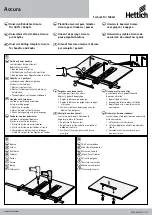
Temperature effect on cycle life
Eternity Technologies recommends that the operating temperature
range for OPzV batteries be within the region of +10°C to + 30°C.
Operating in higher temperatures will lead to decreased operational
life, operating in lower temperatures will lead to a reduction in
available capacity.
Air flow for cooling
When batteries are cycled, they generate heat. Eternity Technologies
recommend a minimum gap of at least 10.0mm between cells to
allow for the heat to disperse from around the cells. Where natural
cooling is not enough to keep the temperature of the battery to a
recommended level, a cooling system may be required. We can work
out the size of the required cooling by calculation, please see below:
A 48V battery is discharged twice daily, delivering 3 hours back-up
and 3kW of power
Heat loss from the battery = 2 (2 discharges/day) x 3kW x 3 hours x
0.15 (15%) = 2.7kWh = 2700Wh per day.
If we calculate the cooling power required to keep the room at a
consistent temperature then we take 2700Wh and divide by 24 hours
= 112.5W
Air exchange to exhaust Hydrogen
Due to the chemistries involved within Eternity Technologies OPzV
battery range, hydrogen evolution and emittance is unavoidable.
Although the levels are minimal, if they are allowed to accumulate
or there is a fault within the system and hydrogen gas increases
to a dangerous level, there is a risk of explosion if a spark or flame
becomes present.
8. Cycle Life
Please see the graph below showing our maximum number of cycles
vs the depth of discharge. There are two lines on the graph. One
line states the charging profile with IU charging profile. The other
line shows the cycle life with an IUI charging profile. The graph is
referenced to 20°C, operating at temperatures either side of this
figure will result in a different number of cycles.
9. Hybrid Applications
Eternity Technologies Solar OPzV batteries can be used in a hybrid
system alongside a diesel generator where the batteries are used
to decrease the run time of the generator. Charging is critical in
this application and the user must ensure that the charging time is
sufficient to fully charge the battery between cycles. Failure to do this
will result in reduced cycle life.
The charging criteria must comply with the figures set out in section 5
of this document.
10. Solar Applications
Batteries used without a generator and no mains power are classified
as solar batteries. The important thing here is to limit the charge and
discharge currents.
When there is an abundance of sunlight, it is necessary to limit the
charge and not overcharge the battery. When there are times of
continuous darkness, it is important not to discharge the battery too
much. Please use the end of discharge voltage recommendations in
this brochure for guidance.
Failure to comply with this will result in reduced capacity and cycle life.
It is recommended to perform a boost charge every 1-3 months in
solar applications.
In order to avoid a build-up of hydrogen to dangerous levels, the
battery room or area needs to be ventilated. We can calculate the
required ventilation based on the number of cells and their capacity.
Eternity Technologies recommends the international standard for the
safety stationary batteries, IEC 62485-2 be consulted.
7. Temperature and Air flow
Temperature effect on float life
Increased temperatures have a great effect on the life of a battery.
When the battery is operated at increased temperatures, the
corrosion of the positive terminal is accelerated which leads to early
failure. When operated at 20°C, Eternity technologies OPzV range of
batteries will last for 20 years. For every 10°C increase in the average
operating temperature, the battery’s life is halved.
The graph below shows the effect of temperature on the float life of
the battery.


























